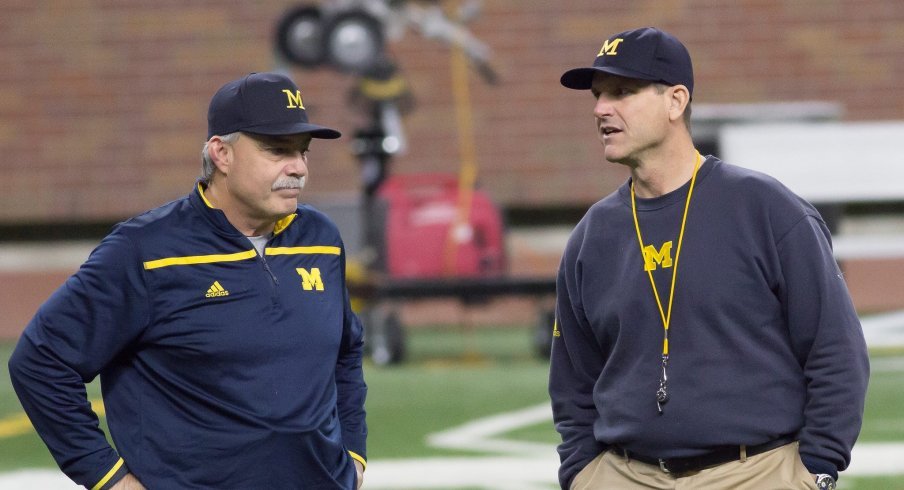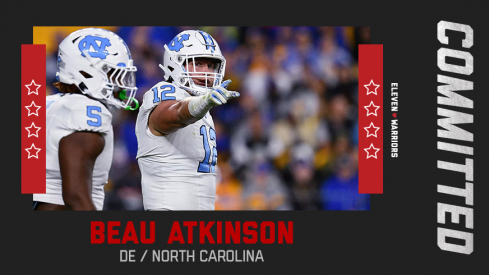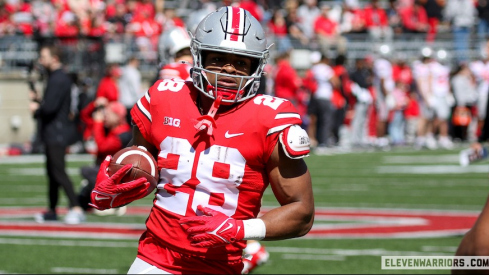With the departure of defensive coordinator D.J. Durkin after the 2015 season, Jim Harbaugh hired Don Brown away from Boston College to be his replacement. Brown did not disappoint in his first season as Michigan posted the nation's #1 ranked defense.
Don Brown comes from the northeast where he spent the majority of his tenure as defensive coordinators of schools such as Boston College, Connecticut, and Maryland. While coordinating Boston College, the Eagles had the #1 ranked defense in 2014 and #9 ranked defense in 2015, all while having little offensive presence.
There may not be a more creative, aggressive defensive coach in the country. Don Brown will play a lot of Cover 1, man-to-man coverage, and a lot of Cover 2 with "trap" coverage employed. This is a very different approach to what is seen in Columbus. Ohio State is a base Cover 4, quarters defense, while you will not find a single example of a Don Brown defense playing quarters as he refuses to play it.
Thanks to James Light, I have a solid understanding of the schemes that Brown uses. If you are curious to learn more about the game of football as a whole, I strongly suggest you give him a follow over on Twitter.
'Red raider'
The most common adjustment to Trips formations for the Wolverine defense is known as 'Red Raider.' This is a split-safety coverage with the defense matching four-over-three to the Trips side and three-over-two to the weak side. This leaves the defense plus-one on each side against the offense.
In 'Red Raider' the Corner to the Trips side is playing press, man-to-man, coverage on the #1 wide receiver. The #1 wide receiver being the receiver farthest from the formation. The Sam linebacker is responsible for playing the curl/flat area but will carry the #2 wide receiver if he runs a vertical route as well as play him man-to-man if he runs an out/wheel route. The Mike linebacker is playing a "scan" technique meaning he will play the #3 wide receiver in man-to-man coverage unless the #2 runs an under/in route immediately. The Rover is "keying" the #2 wide receiver as he will play between #2 and #3 if they are both vertical. If #2 runs an out or an under route, the Rover will squeeze #3 and play him man-to-man with the Mike linebacker.
On the weak side of this coverage, the Corner and Free Safety are playing what is similar to a 'bracket' coverage on the #1 wide receiver. The Corner will play outside and underneath the #1 wide receiver as the Free Safety is playing over the top and inside of #1. If the wide receiver runs an inside route over the middle the Free Safety will jump the route and play the wide receiver. The Will linebacker is "keying" the running back offset in the backfield. He will play the running back man-to-man.
Here is 'Red Raider' from Don Brown's 2013 UCONN Playbook:
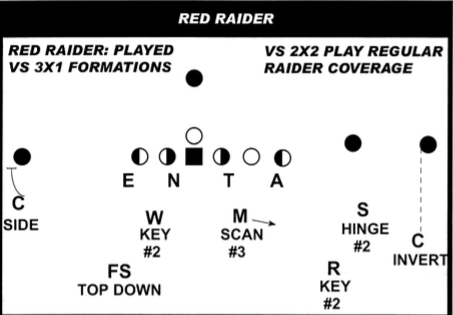
Michigan played a large amount of 'Red Raider' in the November showdown at the Shoe. In the clip below you can see how the Mike linebacker, #42, plays the in route from the #2 wide receiver as Sam, #5, and the Rover, #44, squeeze the vertical route from Samuel. On the backside of this concept, the wide receiver runs a dig route and the Free Safety jumps the route as he is playing any inside breaking route from the #1 wide receiver.
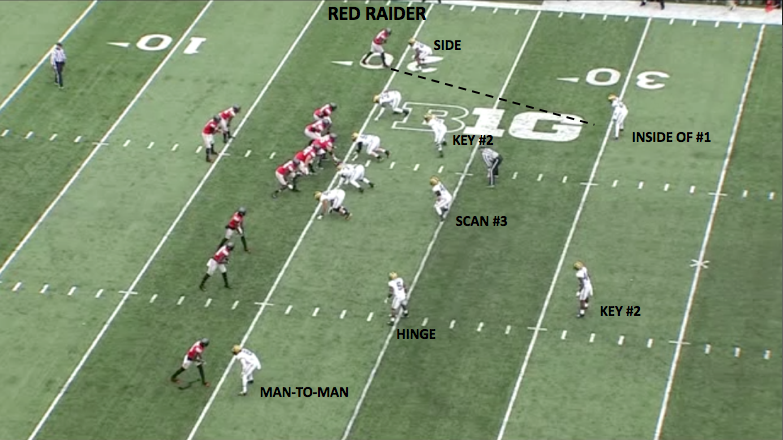
Here is another example where Michigan matches the routes from Ohio State well while forcing J.T. Barrett to scramble.
This next example is against Penn State. Notice how the Nittany Lions attempt to run the weak side wide receiver on a shallow crossing route across the field. This is a popular concept due to all the traffic in the middle of the field, the Corner would usually get picked and the wide receiver would come wide open. Once the wide receiver starts on the crossing route, the Free Safety jumps the route as the Corner rotates back to the middle of the field.
In this example against Colorado, once the Rover sees the #2 run an under route he gets his eyes to #3 and plays him in man-to-man coverage. 'Red Raider' has a lot of answers to many of the route combinations that teams will run out of a trips formation.
'raider blitzes'
'Raider' in Don Brown terminology is "a Man-to-Man coverage with Progression Zone principles." 'Raider' is similar to Nick Saban's 'Rip/Liz' pattern matching defense. With 'Raider' coverage the Corners will be playing man-to-man coverage on the #1 wide receivers while the linebackers and safety will play a "hinge" technique as discussed above.
They are responsible for playing all of the receiver vertical and out but will zone off into coverage if the receiver runs an under route under five yards. Playing this type of pattern-match coverage "allows us to show man-coverage to the offense, but not be beat by Man-Beaters because we can pass off crossers and mesh routes" says Brown.
A common 'Raider' blitz that occurred on film multiple times from this past season was known as 'Spartan Raider'. This is a four-man pressure from Michigan that they dial up on 3rd down quite often. It is tough for the offensive line to block as the defense shows six players walked up to the line of scrimmage. When this occurs the offensive line will generally block the five most dangerous rushers, which, with 'Spartan Raider' would usually be End, Will, Mike, Nose, and Anchor.
The defense then rushes the Nose, Anchor, and Sam off the edge creating a three-on-two versus the offensive tackle and guard. The Sam and Free Safety are playing the "hinge" technique on the #2 receivers with the Mike and Will playing a "funnel" on the running back. Whichever way the running back releases the linebacker to that side will play him in man-to-man coverage while the other linebacker drops into coverage looking for crossers to pick up.
Here is 'Spartan Raider' examples from Brown's UCONN Playbook:
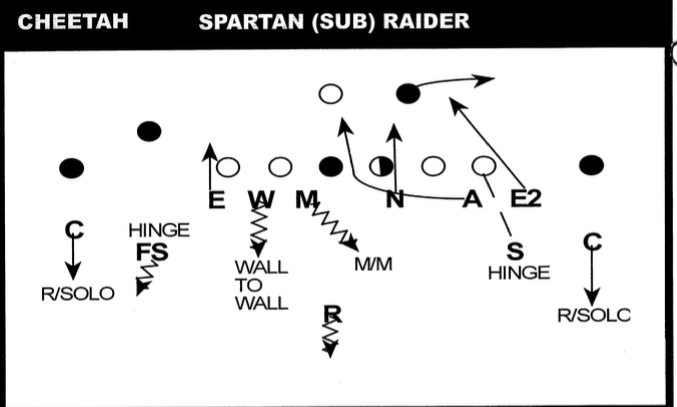
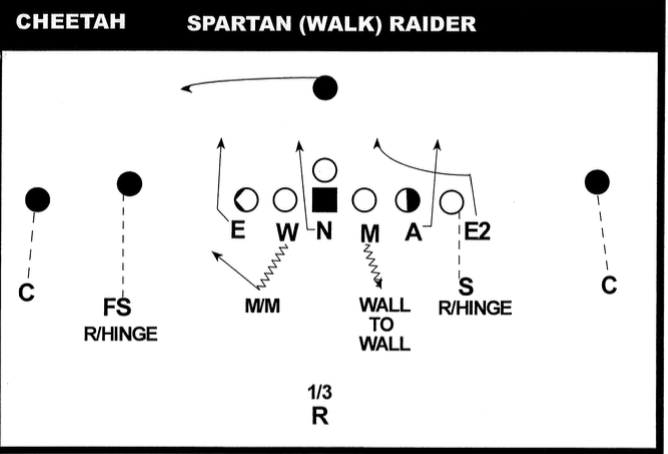
Here are two examples of 'Spartan (Walk) Raider' when the Mike and Will line up on each side of the Nose and drop into coverage:
Here are examples of 'Spartan (Sub) Raider' where the Mike and Will align next to each on the same side of the line:
The key to any pressure/blitz to be effective is winning one-on-one battles up front as Michigan did often last year.
'Pop green'
A blitz that was dialed up often by Don Brown against Ohio State this past season was known as 'Pop Green.' This pressure features another overload to one side of the offensive line with Will and Pup rushing off the edge with the End.
Behind the blitz, the defense is playing a form a "trap" coverage. Playing a "trap" coverage is useful behind any sort of blitz due to the ball usually coming out quick from the quarterback. If the Corner is trapping the flats then he can either deter the quarterback from the quick throw or intercept the ball if he does choose to throw it that way.
With 'Pop Green' the Will linebacker is rushing the 'B' gap, the space between the guard and tackle, while the End loops around him to rush the 'A' gap. The Pup linebacker will rush off the edge. This blitz is effective as the offensive tackle and guard are occupied with Will and End rushing inside, allowing the Pup to rush free off the edge.
As noted already, the Corners behind the blitz are playing "sight" technique. "Sight" in Don Brown terminology is where the Corners have eyes on #2 and are only looking for any out-breaking routes from inside. They are not worried about the #1 wide receiver or re-routing him as he is handled by Rover or Free Safety playing the deep half of the field.
The Sam and Mike are playing what is known as "hash" technique. "Hash" is a spot drop where the linebackers are "responsible for the curl area at 12-14 yards depth and 2-3 yards inside and outside the hash mark."
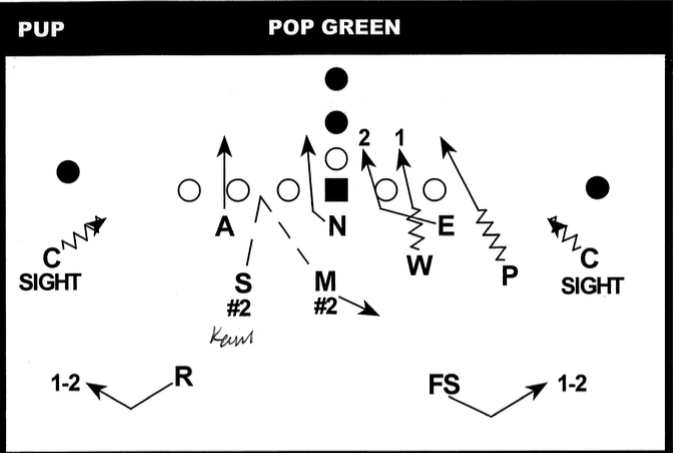
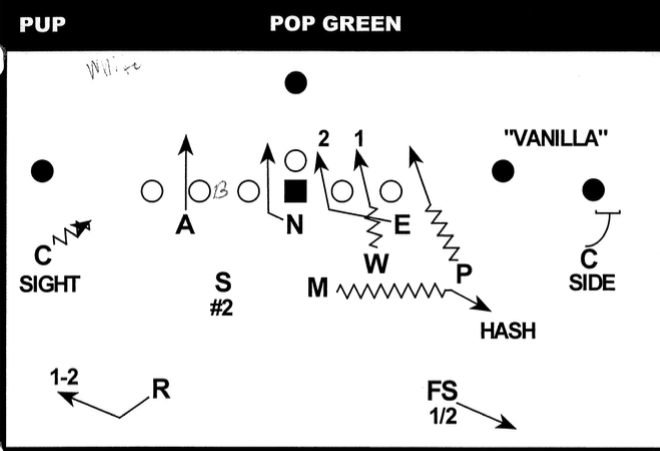
As you can see in the example below the defense does a good job at matching the routes by the Buckeyes while the rush pressures Barrett to get rid of the ball.
In this next example, Michigan is playing an 'invert' trap to the weak side against Ohio State's Trips formation. It's a great adjustment from Don Brown as the Buckeyes had been running the #3 receiver on short crossing routes. Instead of the Corner trapping the flats and the Free Safety playing the deep half of the field, the Free Safety rolls down after the snap to trap the flats and take away a crossing route from Ohio State, had they run one.
With the blitz coming from the backside of the trips formation it helps ensure that Michigan will have more rushers than Ohio State has blockers, resulting in a free rusher to the quarterback for Michigan. While the Will pinches inside and the End loops around into the 'A' gap, it helps occupy the tackle and guard leaving the Pup as the free rusher off the edge.
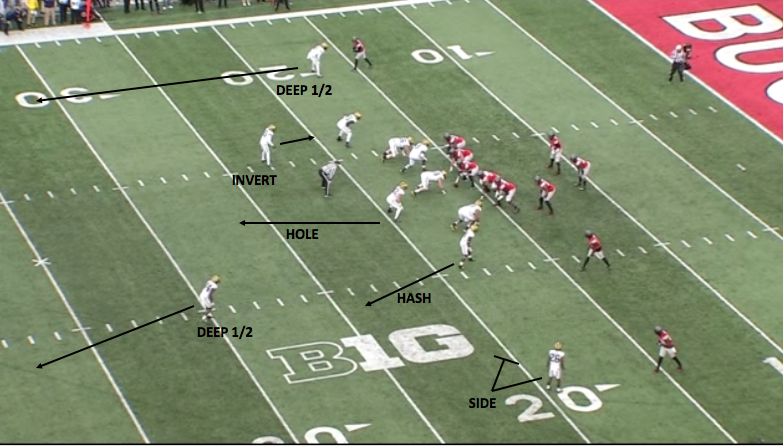
'kamikaze web'
As mentioned above, Don Brown is extremely creative and aggressive. This is apparent as soon as you put on the tape as he is constantly bringing pressure. This blitz, known as 'Kamikaze Web,' is one of the more effective ones he uses. It's also eerily similar to a blitz that Nick Saban and Bill Belichick run. Here is the blitz from Brown's playbook:
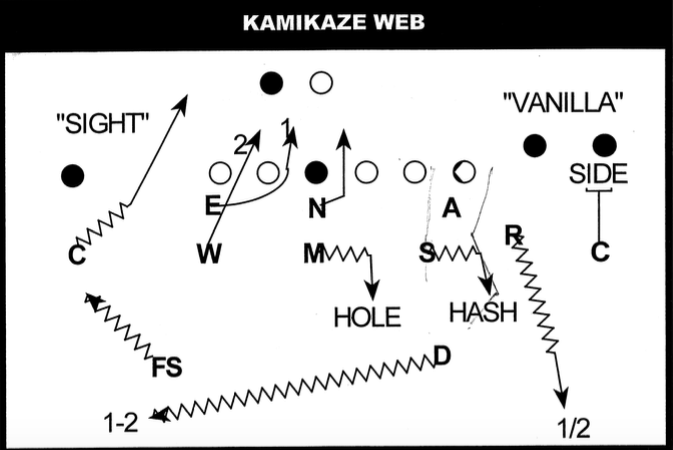
The Corner and Will are blitzing off the weak side while the Free Safety and Dime Safety are rotating to the side of the blitz. Don Brown’s most common coverages behind his blitzes are City, man-coverage, and a Cover 2 trap.
To the side of the blitz the FS is rotating down, playing a “Sight” technique. By trapping the flats, this helps take away any quick throws from the quarterback into the blitz.
The D safety is rotating from the other side of the field to play the deep 1/2 of the field from where the blitz is coming from. The Mike is dropping into coverage, playing a “Hole” technique. Below is a detailed explanation of the “Hole” technique from Don Brown’s 2012 UCONN Linebacker Manual:
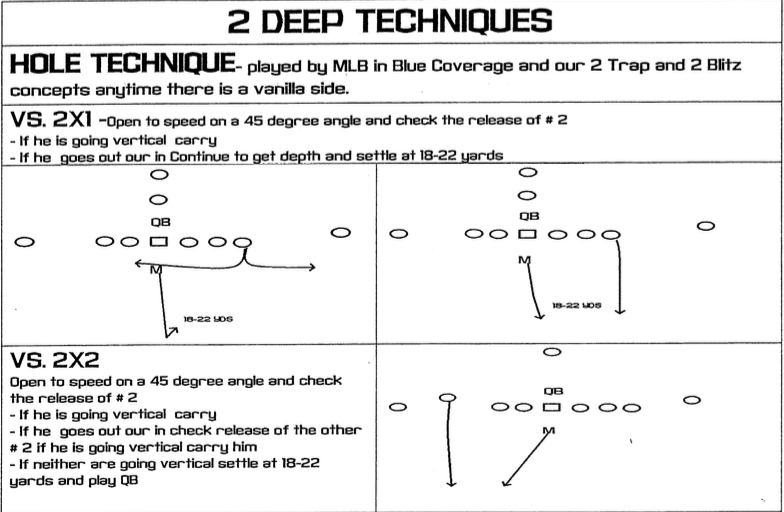
To the field, the Corner is playing “Side” technique. “Side” is a traditional Cover 2 cornerback technique where he is playing outside to prevent an outside release by the wide receiver. The Rover is dropping from his alignment into the deep 1/2 into the field. The Sam is playing a “Hash” technique where he is playing the Curl/Flat area. Below is another detailed explanation of the “Hash” drop in Don Brown’s 2012 UCONN Linebacker Manual:
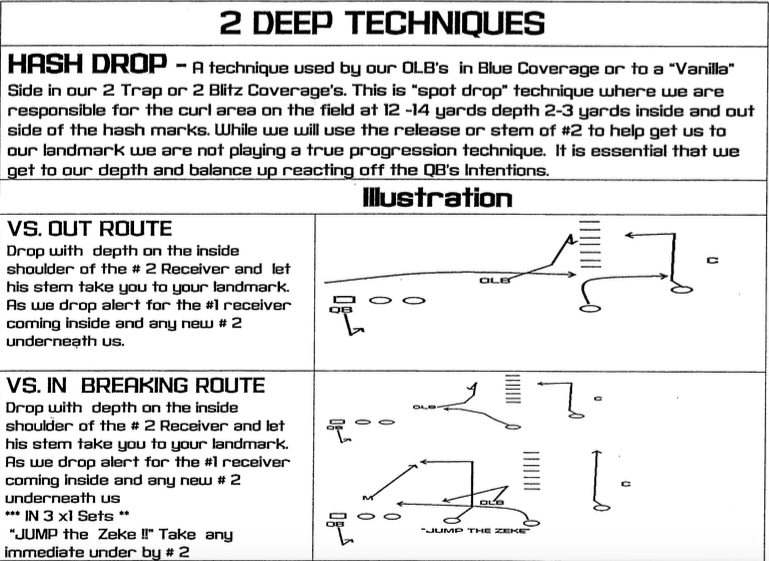
Below is an example of Don Brown dialing up ‘Kamikaze Web’ versus Penn State. Michigan already has the game put out of reach yet Brown is still heating up the blitzes. This blitz comes from the backside of a Trips formation, and the offensive line slides to the right after the play-action fake leaving a one-on-one with the cornerback versus the tight end.
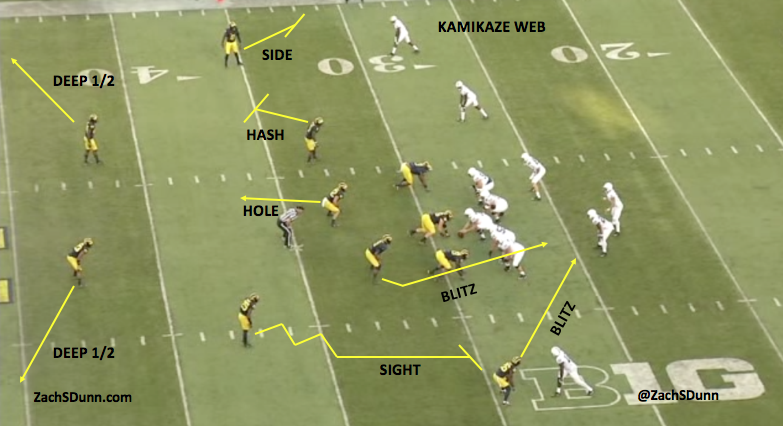
Here is another example in which Don Brown dials up ‘Kamikaze Web’ against a Trips formation in their match-up with Ohio State.
Though the Michigan defense lost a load of starters on going into next season I expect the defense to be just as good again with Don Brown calling the shots. He has had outstanding defenses no matter where he has been, no matter the talent and I do not expect a loss of seniors to drastically affect the defense in the upcoming season.
